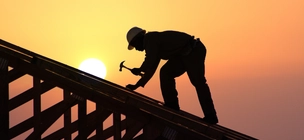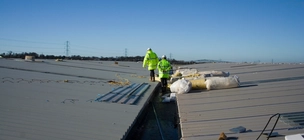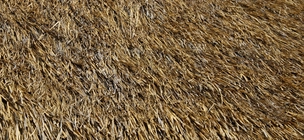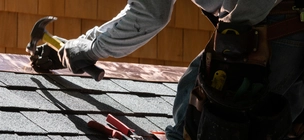Are the green, spongy patches on your roof getting worse every time it rains? Roof moss removal is essential if you want to avoid leaks and expensive repairs. Moss thrives on moisture and can quickly spread across shingles, clay tiles, or even metal roofing panels. In this article, you’ll find out why moss grows, how it harms your roof, and how to remove it effectively.
Common causes of moss growth on your roof
Moss and lichen growth often appears gradually, turning what was once a perfectly clean surface into mossy roof tiles. Here are some common causes of roof moss and lichen growth:
- Moisture retention roof issues: Moss flourishes in damp environments. If your area has high rainfall or humidity, this moisture can stay trapped on your roof’s surface, encouraging growth.
- Shaded surroundings: Overhanging trees, tall buildings, or nearby structures can create constant shade and reduce sunlight, which allows moss to keep growing.
- Poor drainage: Blocked or inadequate gutter and downpipe systems cause water to pool on your roofing, promoting moss and lichen growth.
- Neglected roof maintenance: If you haven’t scheduled regular roof inspections or basic cleaning, small patches of moss can take over large areas in a surprisingly short time.

Without prompt roof maintenance, moss can weaken roof tiles, especially if the tiles are clay or another porous material. Next, let’s look at what can happen if you choose to ignore the problem.
What happens if you don’t remove roof moss?
Overlooking moss and algae on your roof can lead to various short-term and long-term concerns. Addressing moss damage early on ensures a safer and more cost-effective outcome. Here are some consequences of ignoring a mossy roof:
- Reduced roof lifespan: Moss damages shingles or tiles by trapping moisture and causing them to degrade faster.
- Leaks and water infiltration: As moss builds up, it can lift and separate roof materials, letting water seep into your home.
- Structural issues: Continuous water penetration can rot wooden support beams and weaken the entire roof structure.
- Increased energy costs: Damp or compromised roofs often lose their insulating ability, raising your heating or cooling expenses.
Effective strategies for roof moss removal
Below are both short-term fixes and more permanent options. While some steps you can handle yourself, it’s essential to know when professional help is safer and more effective.
1. DIY preventative measures
Before moss becomes a significant issue, simple maintenance can help you stay ahead of it:
- Trim overhanging branches: Increasing direct sunlight on your roof by cutting back trees helps keep surfaces dry, making it harder for moss to thrive.
- Clear the gutters: Make sure rainwater can flow freely down the roof. Clogged gutters contribute to constant dampness, a perfect breeding ground for roof moss.
- Remove debris: Regularly brush off leaves, twigs, and any organic matter to reduce moisture retention.
2. DIY moss removal tips
If moss is already present, you can attempt small-scale removal yourself. Here’s how:
- Safety first: Always use a sturdy ladder and wear non-slip shoes. Consider using a safety harness for steep roofs.
- Gather tools: Use a stiff-bristle brush or broom, a low-pressure garden sprayer, and a recommended moss removal solution available at most hardware stores.
- Apply cleaner: Follow the product instructions carefully. Spray it directly onto affected areas, giving special attention to cracks and overlaps between roof tiles.
- Brush away moss: After letting the solution sit for the recommended time, gently scrub the mossy spots, avoiding harsh scrubbing that could damage shingles or delicate clay tiles.
- Rinse properly: Use a garden hose at low pressure to rinse away any residue. High pressure can loosen tiles and lead to leaks.
Proceed slowly to avoid slipping or missing hidden moss patches. If you’re uncertain about your ladder skills or roofing angle, it might be safer to skip these DIY steps.

3. Professional roof maintenance and moss on shingles solution
Professional roof specialists have the experience and equipment to handle projects of any size, from basic moss scrubbing to comprehensive roof restoration. Services often include:
- Manual or low-pressure washing: Carefully removing thick moss without harming your roof’s surface.
- Preventative treatments: Using specialized moss and algae preventatives to keep your roof cleaner for longer.
- Roof repairs: Replacing damaged tiles, fixing leaks, and resealing vulnerable areas to prevent future infiltration.
When to call a professional
- Your roof is steep or multi-story, making it difficult or dangerous to reach.
- The moss damage extends across large sections of roofing, suggesting deeper structural issues.
- You’ve tried DIY solutions, but the problem keeps coming back.
- You want a lasting fix with a warranty and professional expertise for peace of mind.
Trying to handle all these tasks on your own can be risky. A roof repair or renovation expert can do a more thorough job, helping to prolong your roof’s lifespan.
A fresh perspective on a cleaner roof
Maintaining a moss-free roof isn’t just about looks—it protects your home’s structure and keeps your household safe. A little prevention goes a long way, and if you ever feel uncertain, professionals are ready to assist. If you want an extra advantage, consider scheduling periodic inspections to catch potential problems early. It’s time to enjoy a healthier, longer-lasting roof for years to come.







